By Evelyn F. McCoy, Paige Thompson, Travis Reginal, and Natalie Lima
Jail incarceration continues to be a main driver of the mass incarceration crisis in the United States and to negatively affect individuals, families, and communities. Racial disparities in local jail populations are significant, particularly to the detriment of Black communities. Involvement in the criminal legal system, even when brief, can have severe consequences, including barriers to sustaining employment and securing stable housing, poor physical and mental health stemming from chronic stress and limited access to adequate health care, and disruptions to family relationships and social support networks.
To address these issues, Philadelphia implemented a multipronged reform plan supported by the Safety and Justice Challenge (SJC) to reduce its jail population and associated racial and ethnic disparities. Since 2015, Philadelphia has significantly reduced its jail population through these SJC efforts, which included closing a jail facility, launching a strategy across decision points in the criminal legal system, strengthening collaboration and cross-agency partnerships, launching a formal committee to represent community members’ perspectives, and analyzing data to identify racial and ethnic disparities across decision points. This report describes Philadelphia’s major SJC strategies, documents how it navigated challenges and advanced tangible reform efforts, and explores the perceived impacts of these strategies on its efforts to engage community members, reduce local jail use, and implement system reforms that advance equity. Lessons learned include that it is possible to significantly reduce jail populations in large cities with comprehensive, cross-agency collaboration; that such jail population reductions do not necessarily mean racial and ethnic disparities will also decrease; that reform fatigue is a reality for long-term initiatives like the SJC and can make it difficult for stakeholders to sustain efforts; and that meaningful community engagement is challenging and requires educating stakeholders and community members.
Urban Institute. 2023. 36p.






















